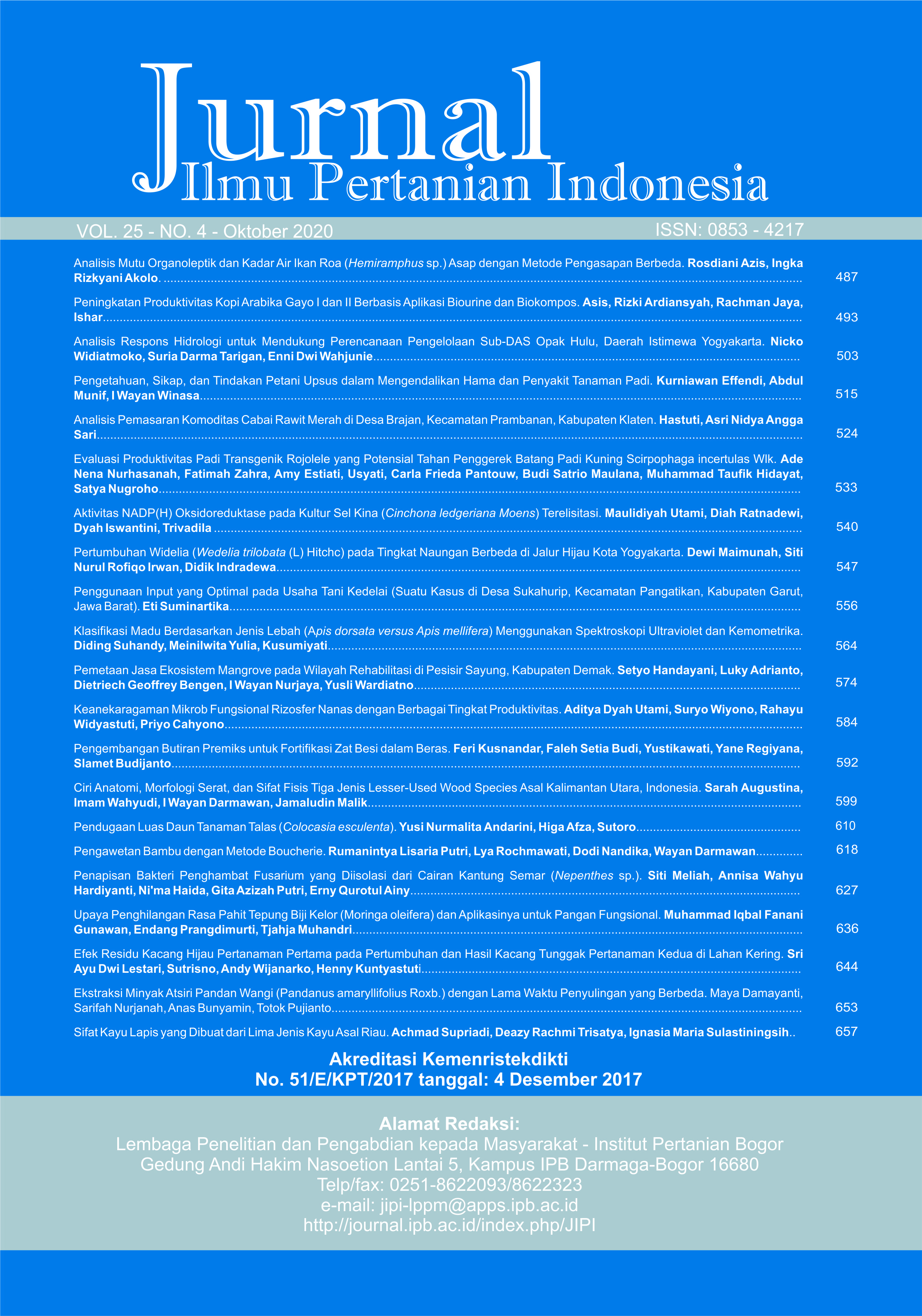Efek Residu Kacang Hijau Pertanaman Pertama pada Pertumbuhan dan Hasil Kacang Tunggak Pertanaman Kedua di Lahan Kering
Abstract
The objective of this research was to determine the residual effect of fertilizer and former plant spacing of mungbean first planting on growth and yield of cowpea second planting in a dry land. The experiment was conducted at Muneng Research Field, Probolinggo, East Java during dry season in 2015. The cowpea seeds of KT 5 varieties were planted in plots measuring 4 m x 4,5 m with plant spacing of 40 cm x 15 cm, 2 plants/hole. This research was carried out without adding fertilizer (fertilizer application only given on mungbean planting). This experiment was laid out in a split plot design and replicated three times. Plant spacing of mungbean as the main plot, namely 1) former of 40 cm x 10 cm, 1 plant/hole (J1); 2) former of 40 cm x 15 cm, 2 plants/hole (J2); and 3) former of 40 cm x 20 cm, 2 plants/hole (J3). Residual combination of organic and inorganic fertilizers as the sub plot, namely 1) former without fertilizer (R0); 2) former of 50 kg ZA + 50 kg SP-36 + 100 kg KCl/ha (R1); 3) former of 150 kg Phonska/ha (R2); 4) former of 5000 kg organic fertilizer/ha (R3); and 5) former of 75 kg Phonska + 2500 kg organic fertilizer/ha (R4). The results showed that the cultivation of cowpea with R3 and R4 treatments had effects on shoot and roots dry weights. The highest cowpea yield was obtained with J3 and R4 treatment of 1,62 t/ha and the highest biomass was obtained with J3 treatment of 5,92 t/ha, but statistically not significantly different from the other treatments.
Keywords: cowpea, dry land, residual fertilizer
Downloads
References
Babaji BA, Yahaya RA, Mahadi MA, Jaliya MM, Ajeigbe HA, Sharifai AI, Kura HN, Arunah OL, Ibrahim A. 2010. Response of cowpea [Vigna unguiculata (L.) Walp] to residual effect to different application rates of sheep manure on chili pepper (Capsicum annuum). Journal of Food, Agriculture, and Environment 8(2): 339343.
Bachtiar, Ghulamahdi M, Melati M, Guntoro D, Sutandi A. 2016. Kecukupan hara fosfor pada pertumbuhan dan produksi kedelai dengan budidaya jenuh air di tanah mineral dan bergambut. Jurnal Ilmu Tanah dan Lingkungan 18(1): 2127. https:// doi.org/10.29244/jitl.18.1.21-27
Bisikwa J, Kawooya R, Ssebuliba JM, Ddungu SO, Biruma M, Okello DK. 2014. Effects of plant density on the performance of local and elite cowpea varieties in Eastern Uganda. African Journal of Applied Agricultural Sciences and Technologies 1(1): 2841.
Chemining’wa GN, Ngeno JK, Hutchinson MJ, Shibairo SL. 2018. Influence of P fertilizer on nodulation, growth, and nutrient content of cowpea (Vigna unguiculata) in acidic soils of South Western Kenya. International Journal of Plant & Soil Science 25(3): 112. https://doi.org/10.9734/IJPSS/2018/44765
Ddamulira G, Santos CAF, Obuo P, Alanyo M, Lwanga CK. 2015. Grain yield and protein content of Brazilian cowpea genotypes under diverse Ugandan environments. American Journal of Plant Sciences 6: 20742084. https://doi.org/10.4236/ ajps.2015.613208
Da Silva DOM, Santos CAF. 2016. Adaptability and stability parameters for potassium and calcium contents and grain yield in cowpea lines. African Journal of Agricultural Research 11(36): 33663374. https://doi.org/10.5897/AJAR2016. 11526
Imthiyas MSM, Seran TH. 2017. Residual effect of goat manure and expert fertilizer treated with proceeding crop of radish (Raphanus sativus L.) on succeeding crop of vegetable cowpea (Vigna unguiculata L.). Annals of Agricultural and Environmental Sciences 2(2): 15.
Kementerian Pertanian. 2015. Rencana Strategis Kementerian Pertanian Tahun 20152019. Biro Perencanaan, Sekretariat Jenderal. Jakarta (ID).
Kuntyastuti H, Lestari SAD. 2016. Pengaruh interaksi antara dosis pupuk dan populasi tanaman terhadap pertumbuhan dan hasil kacang hijau pada lahan kering beriklim kering. Jurnal Penelitian Pertanian Tanaman Pangan 35(3): 239249. https:// doi.org/10.21082/jpptp.v35n3.2016.p239-249
Kuntyastuti H, Muzaiyanah S. 2017. Effect of organic fertilizer and its residual on cowpea and soybean in acid soils. Journal of Degraded and Mining Land Management 5(1): 987994. https://doi.org/ 10.15243/jdmlm.2017.051.987
Lestari SAD, Sutrisno, Kuntyastuti H. 2018. Pengaruh pupuk terhadap pertanaman kacang hijau dan residunya pada tanaman kacang tunggak. Jurnal Ilmu Pertanian Indonesia 23(1): 2128. https:// doi.org/10.18343/jipi.23.1.21
Mulyani A, Sarwani M. 2013. Karakteristik dan potensi lahan sub optimal untuk pengembangan pertanian di Indonesia. Jurnal Sumberdaya Lahan 7(1): 4755.
Robertson GP, Vitousek PM. 2009. Nitrogen in agriculture: balancing the cost of an essensial resource. Annual Review of Environment and Resources 34: 97125. https://doi.org/10.1146/ annurev.environ.032108.105046
Teixeira PEG, Fernandes AR, Galvao JR, Pereira WVdS, Casanova SRA, Filho PPdCA. 2016. Cowpea yield on soils with residues of NPK and natural phosphate fertilizers in succession the area of degraded pasture. Rev. Ceres 63(4): 553567. https://doi.org/10.1590/0034-737X2016630400 S17
Wahyunto, Shofiyati R. 2013. Wilayah Potensial Lahan Kering untuk Mendukung Pemenuhan Kebutuhan Pangan di Indonesia. Dalam Prospek Pertanian Lahan Kering Dalam Mendukung Ketahanan Pangan. IAARD Press. Jakarta (ID). 397 hal.
This journal is published under the terms of the Creative Commons Attribution-NonCommercial 4.0 International License. Authors who publish with this journal agree to the following terms: Authors retain copyright and grant the journal right of first publication with the work simultaneously licensed under a Creative Commons Attribution-NonCommercial 4.0 International License. Attribution — You must give appropriate credit, provide a link to the license, and indicate if changes were made. You may do so in any reasonable manner, but not in any way that suggests the licensor endorses you or your use. NonCommercial — You may not use the material for commercial purposes.























